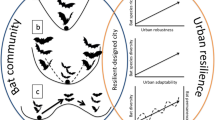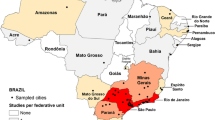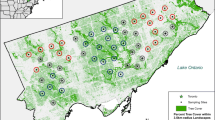Abstract
Cities are characterised by low amounts of natural habitat, so their human populations, i.e. urbanites, are expected to be poorly connected to and knowledgeable about the natural world, despite high biodiversity levels being increasingly recorded in unconventional, urban habitats. Such disconnection may raise potential conservation issues for wildlife living in urban areas. Bats are common in cities around the world and so too, therefore, are interactions between bats and urbanites. Yet, the elusive habits and peculiar adaptations of bats make these mammals poorly known and even feared, often as a consequence of long-standing, negative cultural framing. Here, we review the available literature on the human dimensions of urban bats. We first present a potential theoretical framework for understanding the drivers of human-bat relationships and how it applies to the available literature on urban bats. Next, we present an array of potential real-life contexts in which human-bat interactions may occur in urban areas worldwide. Such interactions vary in their nature and context and include visits to zoos, rescue, volunteering, occasional encounters, and the installation of bat boxes. Finally, we present a focal case study investigating attitudes towards and knowledge of bats from a tropical city.
Access this chapter
Tax calculation will be finalised at checkout
Purchases are for personal use only
Similar content being viewed by others
Literature Cited
Blair RB (2001) Birds and butterflies along urban gradients in two ecoregions of the United States: is urbanization creating a homogeneous fauna? In: Lockwood JL, McKinney ML (eds) Biotic homogenization. Springer, Boston, pp 33–56
Hwang YH, Jain A (2021) Landscape design approaches to enhance human–wildlife interactions in a compact tropical city. J Urban Ecol 7(1):juab007
Mascia MB et al (2003) Conservation and the social sciences. Conserv Biol 17(3):649–650
Kingston T (2016) Cute, creepy, or crispy—how values, attitudes, and norms shape human behavior toward bats. In: Voigt CC, Kingston T (eds) Bats in the anthropocene: conservation of bats in a changing world. Springer International Publishing, Cham, pp 571–595
Soga M, Gaston KJ (2016) Extinction of experience: the loss of human–nature interactions. Front Ecol Environ 14(2):94–101
Oh RRY et al (2020) No evidence of an extinction of experience or emotional disconnect from nature in urban Singapore. People Nat 2(4):1196–1209
Cox DTC et al (2017) Doses of neighborhood nature: the benefits for mental health of living with nature. Bioscience 67(2):147–155
Russo D, Ancillotto L (2015) Sensitivity of bats to urbanization: a review. Mamm Biol 80(3):205–212
Santini L et al (2019) One strategy does not fit all: determinants of urban adaptation in mammals. Ecol Lett 22(2):365–376
MacFarlane D, Rocha R (2020) Guidelines for communicating about bats to prevent persecution in the time of COVID-19. Biol Conserv 248:108650
Bennett NJ et al (2017) Conservation social science: understanding and integrating human dimensions to improve conservation. Biol Conserv 205:93–108
Fulton DC, Manfredo MJ, Lipscomb J (1996) Wildlife value orientations: a conceptual and measurement approach. Hum Dimens Wildl 1(2):24–47
Vaske JJ, Donnelly MP (1999) A value-attitude-behavior model predicting wildland preservation voting intentions. Soc Nat Resour 12(6):523–537
Whittaker D, Vaske JJ, Manfredo MJ (2006) Specificity and the cognitive hierarchy: value orientations and the acceptability of urban wildlife management actions. Soc Nat Resour 19(6):515–530
Ajzen I (2020) The theory of planned behavior: frequently asked questions. Hum Behav Emerg Technol 2(4):314–324
Jacobs MH, Vaske JJ, Roemer JM (2012) Toward a mental systems approach to human relationships with wildlife: the role of emotional dispositions. Hum Dimens Wildl 17(1):4–15
Castillo-Huitrón NM et al (2020) The importance of human emotions for wildlife conservation. Front Psychol 11(1277):1–11
Straka TM et al (2021) Human dimensions of bat conservation – 10 recommendations to improve and diversity studies of human-bat interactions. Biol Conserv. In revision
Kellert SR (1993) Values and perceptions of invertebrates. Conserv Biol 7(4):845–855
Knight AJ (2008) “Bats, snakes and spiders, Oh my!” how aesthetic and negativistic attitudes, and other concepts predict support for species protection. J Environ Psychol 28(1):94–103
López-Baucells A, Rocha R, Fernández-Llamazares Á (2018) When bats go viral: negative framings in virological research imperil bat conservation. Mammal Rev 48(1):62–66
Low M-R et al (2021) Bane or blessing? Reviewing cultural values of bats across the Asia-Pacific region. J Ethnobiol 41(1):18–34. 17
Kellert SR (1984) Urban American perceptions of animals and the natural environment. Urban Ecol 8(3):209–228
Boso À et al (2021) Understanding human attitudes towards bats and the role of information and aesthetics to boost a positive response as a conservation tool. Anim Conserv n/a(n/a)
Pérez B et al (2021) Design and psychometric properties of the BAtSS: a new tool to assess attitudes towards bats. Animals 11(2):244
Sexton NR, Stewart SC (2007) Understanding knowledge and perceptions of bats among residents of Fort Collins, Colorado. Fort Collins, p 22
Prokop P, Tunnicliffe SD (2008) “Disgusting” animals: primary school children’s attitudes and myths of bats and spiders. Eurasia J Math Sci Technol Educ 4(2):87–97
Schlegel J, Rupf R (2010) Attitudes towards potential animal flagship species in nature conservation: a survey among students of different educational institutions. J Nat Conserv 18(4):278–290
Kellert SR, Wilson EO (1993) The biophilia hypothesis. Island Press, Washington, DC
Moss AG, Pavitt B (2019) Assessing the effect of zoo exhibit design on visitor engagement and attitudes towards conservation. J Zoo Aquarium Res 7(4):186–194
Kahn PH et al (2008) Moral and fearful affiliations with the animal world: children’s conceptions of bats. Anthrozoös 21(4):375–386
Bagstad KJ, Wiederholt R (2013) Tourism values for Mexican free-tailed bat viewing. Hum Dimens Wildl 18(4):307–311
Serangeli MT et al (2012) The post-release fate of hand-reared orphaned bats: survival and habitat selection. Anim Welf 21(1):9–18
Santos NDJ et al (2019) Evaluation of bat-related knowledge, perceptions, and practices in an urban community: a strategy for conservation biology and health promotion. Braz J Biol Sci 6(13):347–358
Markus N, Blackshaw JK (1998) Motivations and characteristics of volunteer flying-fox rehabilitators in Australia. Anthrozoös 11(4):203–209
Kravchenko K et al (2017) Year-round monitoring of bat records in an urban area: Kharkiv (NE Ukraine), 2013, as a case study. Turkish J Zool 41:530–548
Zhang W, Goodale E, Chen J (2014) How contact with nature affects children’s biophilia, biophobia and conservation attitude in China. Biol Conserv 177:109–116
Agnelli P et al (2011) Artificial roosts for bats: education and research. The “Be a bat’s friend” project of the Natural History Museum of the University of Florence. Hystrix Ital J Mammal 22(1)
Bideguren G et al (2019) Bat boxes and climate change: testing the risk of over-heating in the Mediterranean region. Biodivers Conserv 28(1):21–35
Gifford R, Nilsson A (2014) Personal and social factors that influence pro-environmental concern and behaviour: a review. Int J Psychol 49(3):141–157
Lane DJW, Kingston T, Lee BPYH (2006) Dramatic decline in bat species richness in Singapore, with implications for Southeast Asia. Biol Conserv 131(4):584–593
Yeo J-H, Neo H (2010) Monkey business: human–animal conflicts in urban Singapore. Soc Cult Geogr 11(7):681–699
Prokop P, Fančovičová J, Kubiatko M (2009) Vampires are still alive: Slovakian students’ attitudes toward bats. Anthrozoös 22(1):19–30
Tarrant MA, Bright AD, Ken Cordell H (1997) Attitudes toward wildlife species protection: assessing moderating and mediating effects in the value-attitude relationship. Hum Dimens Wildl 2(2):1–20
Lunney D, Moon C (2011) Blind to bats: Traditional prejudices and today’s bad press render bats invisible to public consciousness. In: Law B et al (eds) The biology and conservation of Australasian Bats. Royal Zoological Society of New South Wales, pp 44–63
van Giesen RI et al (2015) Affect and cognition in attitude formation toward familiar and unfamiliar attitude objects. PLoS One 10(10):e0141790
Edwards K (1990) The interplay of affect and cognition in attitude formation and change. J Pers Soc Psychol 59(2):202–216
Festinger L (1962) Cognitive dissonance. Sci Am 207(4):93–106
Rocklage MD, Fazio RH (2018) Attitude accessibility as a function of emotionality. Personal Soc Psychol Bull 44(4):508–520
Rocha R, López-Baucells A, Fernández-Llamazares Á (2021) Ethnobiology of bats: exploring human-bat inter-relationships in a rapidly changing world. J Ethnobiol 41(1):3–17. 15
Barlow KE et al (2015) Citizen science reveals trends in bat populations: the National bat Monitoring Programme in Great Britain. Biol Conserv 182:14–26
Miller ZD et al (2018) Targeting your audience: wildlife value orientations and the relevance of messages about bear safety. Hum Dimens Wildl 23(3):213–226
Lu M et al (2021) Does public fear that bats spread COVID-19 jeopardize bat conservation? Biol Conserv 254:108952
Pérez B, Álvarez B, Boso A, Lisón F (2021) Design and psychometric properties of the BAtSS: a new tool to assess attitudes towards bats. Animals 11(2):244. https://doi.org/10.3390/ani11020244
Author information
Authors and Affiliations
Corresponding author
Editor information
Editors and Affiliations
Rights and permissions
Copyright information
© 2022 The Author(s), under exclusive license to Springer Nature Switzerland AG
About this chapter
Cite this chapter
Ancillotto, L., Coleman, J.L., Gibellini, A.M., Russo, D. (2022). Human Dimensions of Bats in the City. In: Moretto, L., Coleman, J.L., Davy, C.M., Fenton, M.B., Korine, C., Patriquin, K.J. (eds) Urban Bats. Fascinating Life Sciences. Springer, Cham. https://doi.org/10.1007/978-3-031-13173-8_10
Download citation
DOI: https://doi.org/10.1007/978-3-031-13173-8_10
Published:
Publisher Name: Springer, Cham
Print ISBN: 978-3-031-13172-1
Online ISBN: 978-3-031-13173-8
eBook Packages: Biomedical and Life SciencesBiomedical and Life Sciences (R0)




